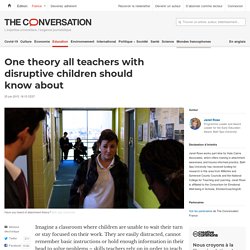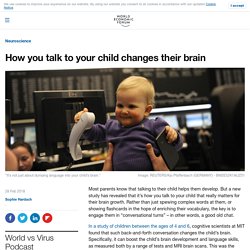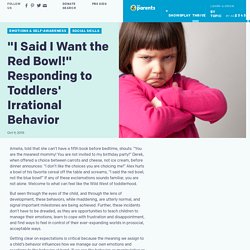

Alaaaboudy
Pre-birth to Three: Observation, Assessment and Planning. This ‘Kindness Curriculum’ Is Free And Should Be Used In Every Classroom. Imagine living in a world that valued kindness enough to teach it along with academics.
Educators would teach kids to manage their emotions in addition to standard curriculum such as math and science. Sounds pretty amazing, doesn’t it? Well, the Center for Healthy Minds at the University of Wisconsin-Madison has created a free “kindness curriculum” for kids, designed to do just that. It’s a mindfulness-based curriculum for preschoolers that will bring kindness into the classroom. “Faced with mental and physical health challenges at a global scale, we conduct rigorous scientific research to bring new insights and tools aimed at improving the wellbeing of people of all backgrounds and ages,” states the Center’s mission statement.
21 Of The Best Early Years Books For International Friendship Day. We know that skills like empathy aren’t fully developed until later in a child’s life, which is why there are so many stories on friendship and how to treat people aimed at Early Years. International Friendship Day, then, is a great opportunity to share some of these amazing books with your children. It does, however, fall on Sunday 30 July. So celebrating on the day itself is going to be difficult, doubly so for Reception classes who are on summer holidays. Here are our picks for some top tales that touch on various aspects of friendship that kids will love. 1 | Bubble Trouble Tom Percival (Bloomsbury, paperback, £6.99) The Key to Effective Classroom Management. It’s a daunting but all-too-common sight for many teachers: A classroom full of rowdy students who are unable to focus on the lesson.
Classroom management techniques may get things back on track, but valuable time has already been lost. Many experienced teachers know that making meaningful connections with students is one of the most effective ways to prevent disruptions in the first place, and a new study set out to assess this approach. In classrooms where teachers used a series of techniques centered around establishing, maintaining, and restoring relationships, academic engagement increased by 33 percent and disruptive behavior decreased by 75 percent—making the time students spent in the classroom more worthwhile and productive. “Strong teacher-student relationships have long been considered a foundational aspect of a positive school experience,” explains Clayton Cook, the lead author of the study and a professor at the University of Minnesota. Relationship reflection form. A 19-Year Study Reveals Kindergarten Students With These 2 Skills Are Twice as Likely to Obtain a College Degree (and They Have Nothing to Do With Reading)
One theory all teachers with disruptive children should know about. Imagine a classroom where children are unable to wait their turn or stay focused on their work.

They are easily distracted, cannot remember basic instructions or hold enough information in their head to solve problems – skills teachers rely on in order to teach successfully. These behavioural issues are all examples of problems that can arise from attachment issues – based on the relationship between children and their main caregiver. Attachment theory is now one of the world’s most well-researched theories about human development. It was first proposed by the 20th-century British psychiatrist John Bowlby, who considered that children needed to develop a secure attachment with their main caregiver via sufficiently consistent, responsive, sensitive, appropriate and predictable care and support.
Don't Expect Toddlers To Behave Consistently — They Literally Can't. One day, when my oldest daughter was not quite 2, she wouldn’t sit still to let me change her diaper. Squirrelly and writhing, she made a game out of staying half naked. She wasn’t fussing about it or anything — in fact, she was giggling maniacally. The problem was that we were running late. Can Free Play Prevent Depression and Anxiety In Kids? Can Free Play Prevent Depression and Anxiety In Kids? Public Media for Northern CA.
Public Media for Northern CA. Key Person & Attachment - Early Years Matters. The Key Person Children thrive from a base of loving and secure relationships. This is normally provided by a child’s parents but it can also be provided by a key person. How Are Happiness and Learning Connected? As teachers, we also know that when students' affective filters or defenses are sky high, fight or flight responses will be modus operandi. A room full of defensive behaviors (withdrawn, angry) is a sad, unproductive place to teach and learn. What to consider when teaching English in large classes. How many students do you teach? Do you feel that your classes are too big? Author and education consultant Jason Anderson looks at the issues and offers some potential solutions. For many of us, our classes are larger than we would like them to be.
Whole Child Development Is Undervalued. The question is how to make such an approach both systemic and sustainable. Whole Person Socio-emotional, physical, creative, and cognitive capacities are deeply intertwined and equally important in ensuring a child's wellbeing, learning, and growth. (That shouldn't be a surprise to anyone studying or supporting children's learning.) Nobel laureate James Heckman, a professor of economics at the University of Chicago, has shown that the non-cognitive skills emerging in early childhood are among the strongest predictors of adult outcomes.
The Art of Control. Executive function — our ability to remember and use what we know, defeat our unproductive impulses, and switch gears and adjust to new demands — is increasingly understood as a key element not just of learning but of lifelong success. Researchers at the Center on the Developing Child at Harvard University describe executive function as an air traffic control system for the mind — helping us manage streams of information, revise plans, stay organized, filter out distractions, cope with stress, and make healthy decisions.
Children learn these skills first from their parents, through reliable routines, meaningful and responsive interactions, and play that focuses attention and stirs the beginnings of self-control. But when home is not stable, or in situations of neglect or abuse, executive function skills may be impaired, or may not develop at all, limiting a child’s success in elementary school and later life.
How to help your child learn English with YouTube videos. Tracey Chapelton, education consultant and materials writer, has some advice for parents of young English learners, whose home language might not be English. To learn a language we need a lot of exposure to it. YouTube is beneficial if you are not a fluent English speaker, and want a more fluent model of English for your child.
Helped along by the visuals of their favourite cartoon, children can watch their favourite characters involved in adventures, while absorbing the language. Repetition is also important for language learning. Practical tips. By Opal Dunn, educational consultant and author Introduction Young children learn English differently from most adults.

Most have an innate ability to pick up English while taking part in activities, by making sense of what they are doing and picking up the adult’s language that accompanies the activity. You can find out more in the British Council booklet ‘How young children learn English as another language’, also available on the parents pages of the LearnEnglish Kids website. Serve and Return. The Brain-Changing Power of Conversation. The Science Researchers used highly faithful audio recorders — a system called Language Environment Analysis (known as LENA) — to capture every word spoken or heard by 36 4–6 year olds from various socioeconomic backgrounds over two full days.
The recordings were analyzed to measure the number of words spoken by each child, the number of words spoken to each child, and the number of conversational turns — back-and-forth exchanges initiated by either adult or child. Comparing those measurements with brain scans of the individual children, the analysis found that differences in the number of conversational turns accounted for differences in brain physiology, as well as for differences in language skills including vocabulary, grammar, and verbal reasoning.
MIT Brain Study: Back-And-Forth Talk Key To Developing Kids' Verbal Skills. New MIT research finds that for children's brain development, parents don't just need to talk to their kids — it's important to talk with them, in back-and-forth exchanges. "What we found is, the more often parents engaged in back-and-forth conversation with their child, the stronger was the brain response in the front of the brain to language," said cognitive neuroscience professor John Gabrieli. Story continues below Most Viewed Stories That stronger brain response, measured as children ages 4 to 6 lay in a scanner listening to simple stories, reflects a deeper, more intimate engagement with language, said graduate student Rachel Romeo.
How you talk to your child changes their brain. Most parents know that talking to their child helps them develop.

But a new study has revealed that it’s how you talk to your child that really matters for their brain growth. Rather than just spewing complex words at them, or showing flashcards in the hope of enriching their vocabulary, the key is to engage them in “conversational turns” – in other words, a good old chat. Carol Dweck: The power of believing that you can improve. How can parents and teachers best educate young children? Teaching large classes. What to consider when teaching English in large classes. Surprisingly Simple Techniques for Challenging Behaviour - Kathy Brodie Early Years Training. Schema and Fairies - Kathy Brodie Early Years Training.
Schemas are one of those things that divide practitioners, like fairies at the bottom of the garden. Schemas in Children’s Play. "I Said I Want the Red Bowl!" Responding to… Amelia, told that she can’t have a fifth book before bedtime, shouts: “You are the meanest mommy!

Does my toddler have a short attention span because she won’t sit still for a story? OPOL, One Person, One Language - Bilingual Kidspot. Last Updated on March 4, 2020.

FAQ: Raising Bilingual Children. Why play-based learning? - Early Childhood Australia. Play to Learn. Play to Learn: Discussion. Why Movement is Essential in Early Childhood. Primary school shake-up to focus on ‘play-led’ learning. Low-cost play ideas: video.
Choice page. The cognitive benefits of play: Effects on the learning brain. Symbolic play and language development. Deconstructing Role Play – Provide the Resources, Step Back and Watch Children’s Learning Flourish. Heuristic play. Multilingual Preschoolers. How can I help my child to start talking? (Video) Why does my toddler love repetition? Why does my toddler love repetition? Let's Talk.
Deb Roy: The birth of a word. Listen to Your Mother. FAQ: Raising Bilingual Children. You speak with an accent. I don’t. Early childhood development – it’s not rocket science, it’s neuroscience! - Kathy Brodie Early Years Training. How baby brains develop. The Woman Who Changed Her Brain: Barbara Arrowsmith-Young at TEDxToronto. How do you speak 'Motherese'? The Power of Evening Routines.
How young children learn English as another language. Early childhood care and education. You Should Definitely Encourage Your Child's Dinosaur Obsession - Kitchen Fun With My 3 Sons. Teaching large classes. Teaching large classes. What to consider when teaching English in large classes. Low-cost play ideas: video. Surprisingly Simple Techniques for Challenging Behaviour - Kathy Brodie Early Years Training.
Schema and Fairies - Kathy Brodie Early Years Training. Schemas in Children’s Play. "I Said I Want the Red Bowl!" Responding to… Does my toddler have a short attention span because she won’t sit still for a story? OPOL, One Person, One Language - Bilingual Kidspot. FAQ: Raising Bilingual Children. FAQ: Raising Bilingual Children. Stages of Object Permanence for CTET and State TET Exams. Taking Playtime Seriously. Importance of play for babies & children. How young children learn English through play. Play. أفكار الرياضيات. Heuristic play. Why does my toddler love repetition? How can I help my child to start talking? (Video) Multilingual Preschoolers. Public Media for Northern CA.
Patricia Kuhl: The linguistic genius of babies. Alison Gopnik: What do babies think? How young children learn English as another language. ScopeSequenceMMSCurriculum. Living montessori now.